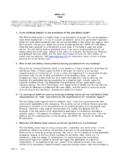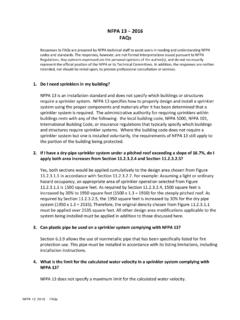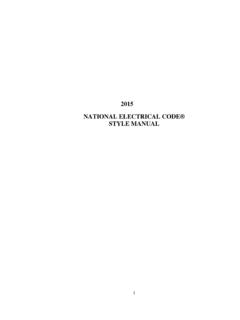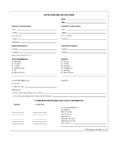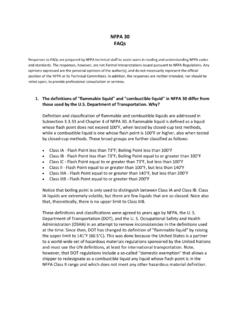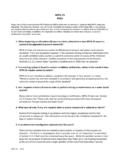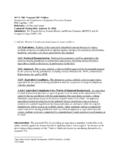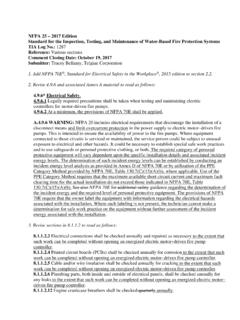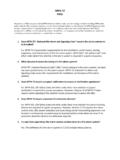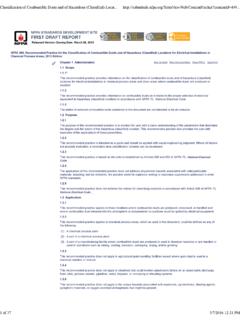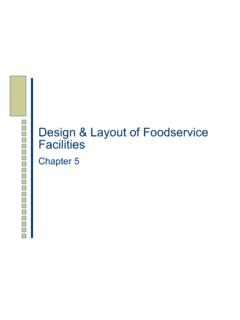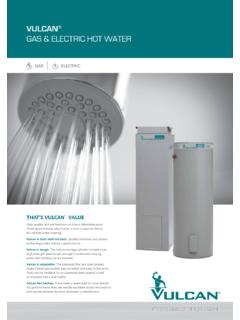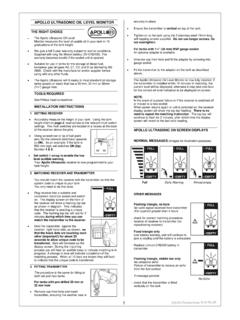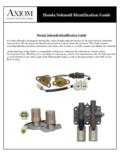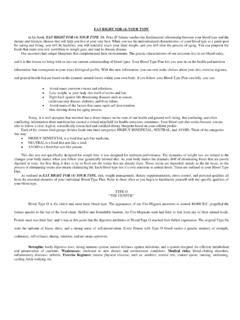Transcription of Sprinkler Protection Guidance for Lithium-Ion Based Energy ...
1 Sprinkler Protection Guidance for Lithium-Ion Based Energy Storag e Systems FINAL REPORT BY: Long, Jr., , CFEIAmy M. Misera, CFEIE xponent, Inc. Bowie, MD, USA June 2019 2019 Fire Protection Research Foundation 1 Batterymarch Park, Quincy, MA 02169-7417, USA Email: | Web: Page ii FOREWORD The 2016 Fire Protection Research Foundation project Fire Hazard Assessment of Lithium Ion Battery Energy Storage Systems identified gaps and research needs to further understand the fire hazards of lithium ion battery Energy storage systems. There is currently limited data available on the fire hazard of Energy storage systems (ESS) including two full-scale open-air tests from the 2016 Foundation project and a separate project that included intermediate scale fire testing conducted at the module level to evaluate the performance of fire suppressants. The fire Protection and fire service communities need Guidance on Protection requirements for these systems in a building.
2 The Research Foundation initiated this project to determine Sprinkler Protection Guidance for grid-connected Lithium-Ion battery Based ESS for commercial occupancies. This report includes a summary of the small-scale and large-scale experimental testing undertaken for this project and the resulting Protection recommendations. The Fire Protection Research Foundation expresses gratitude to the report authors R. Thomas Long, Jr., , CFEI, and Amy M. Misera, who are with Exponent, Inc. located in Bowie, MD, USA. The Research Foundation appreciates the Guidance provided by the Project Technical Panelists, the funding provided by the Property Insurance Research Group (PIRG), and all others that contributed to this research effort. The Foundation also expresses gratitude to NEC Energy Solutions, Inc. and Retriev Technologies for their donations to support the project. Special thanks are expressed to FM Global who donated their resources to complete the fire testing.
3 A separate FM Global report containing the results from this experimental effort, as well as additional test results and expanded data analysis, can be found at: The content, opinions and conclusions contained in this report are solely those of the authors and do not necessarily represent the views of the Fire Protection Research Foundation, NFPA, Technical Panel or Sponsors. The Foundation makes no guaranty or warranty as to the accuracy or completeness of any information published herein. About the Fire Protection Research Foundation The Fire Protection Research Foundation plans, manages, and communicates research on a broad range of fire safety issues in collaboration with scientists and laboratories around the world. The Foundation is an affiliate of NFPA. Page iii About the National Fire Protection Association (NFPA) Founded in 1896, NFPA is a global, nonprofit organization devoted to eliminating death, injury, property and economic loss due to fire, electrical and related hazards.
4 The association delivers information and knowledge through more than 300 consensus codes and standards, research, training, education, outreach and advocacy; and by partnering with others who share an interest in furthering the NFPA mission. All NFPA codes and standards can be viewed online for free. NFPA's membership totals more than 65,000 individuals around the world. Keywords: Energy storage systems, Energy storage, li-ion battery, Lithium-Ion , ESS, fire hazard of ESS, Sprinkler Protection of ESS Report number: FPRF-2019-06-REV Page iv Page v PROJECT TECHNICAL PANEL Jim Biggins, Global Risk Consultants Andrew Blum, Fisher Engineering Tom De Lucia, NEC Energy Solutions Laurie Florence, UL Kevin Fok, LG Chem Jan Gromadzki, Tesla Kevin Marr, University of Texas Dirk Long, Renewable Energy Systems (RES) Celina Mikolajczak, Uber Erin Minear, Energy Storage Integration Council Leo Subbarao, FDNY Nick Warner, Warner Energy Storage Solutions and ESRG Brian O Connor, NFPA PROJECT SPONSORS Property Insurance Research Group (PIRG).
5 AIG CNA Insurance FM Global Liberty Mutual Insurance Tokio Marine America Travelers Insurance Verisk Zurich Insurance Group Page vi Page vii Thermal Sciences Sprinkler Protection Guidance for Lithium-Ion Based Energy Storage Systems - 7128 Sprinkler Protection Guidance for Lithium-Ion Based Energy Storage Systems Prepared for: Fire Protection Research Foundation One Batterymarch Park Quincy, MA 02169 Prepared by: R. Thomas Long, Jr., , CFEI Amy M. Misera, CFEI Exponent, Inc. 17000 Science Drive Suite 200 Bowie, MD 20715 May 29, 2019 Exponent, Inc. - 7128 iiContents Page List of Figures iv List of Tables v Acronyms and Abbreviations vi Limitations vii Executive Summary viii 1 Introduction 1 2 Existing ESS Sprinkler Protection Guidance Documents 2 3 Battery Description and Test Set Up 3 Commodity/Battery Descriptions 3 Test Facility and Set Up 4 4 Small-Scale Free Burn Tests 5 Small-Scale Free Burn Test Set Up 5 Small-Scale Free Burn Test Results 5 5 Intermediate-Scale Free Burn Tests 7 Intermediate-Scale Free Burn Test Set up 7 Intermediate-Scale Free Burn Test Results 7 6 Large-Scale Free Burn Tests 10 Large-Scale Free Burn Test Set up 10 Large-Scale Free Burn Test Results 11 7 Large-Scale Sprinklered Tests 15 Large-Scale Sprinklered Test Set up 15 Sprinkler layout 16 Large-Scale Sprinklered Test Results 16 Sprinkler Performance 19 8 Applications to Sprinkler Protection Guidance 21 - 7128 iii 9 Conclusions 25 10 Recommendations 27 11 Possible Future Work 28 12 Acknowledgements 29 11
6 References 30 - 7128 ivList of Figures Page 34571012121314151617 171819202122 Figure 1. Battery cell description. Figure 2. LFP and LNO/LMO battery chemistry mass and Energy information. Figure 3. Small-scale free burn test set up. Figure 4. Intermediate-scale free burn test set up. Figure 5. Large-scale free burn test set up. Figure 6. LFP fire development during large-scale free burn test. Figure 7. LNO/LMO fire development during large-scale free burn test. Figure 8. LFP full-scale free burn HRR. Figure 9. LNO/LMO full-scale free burn HRR. Figure 10. Large-scale sprinklered test set up. Figure 11. Large-scale sprinklered test set up. Figure 12. LFP fire development during large-scale sprinklered test. Figure 13. LNO/LMO fire development during large-scale sprinklered test. Figure 14. LFP large-scale sprinklered test HRR curve. Figure 15. LNO/LMO large-scale sprinklered test HRR curve. Figure 16. Sprinkler layout and operation overview for LFP (left) and LNO/LMO (right).
7 Figure 17. LFP and LNO/LMO free burn and sprinklered HRR comparison. Figure 18. LFP and LNO/LMO free burn and sprinklered threshold comparison. Figure 19. Diagram of three primary rack configurations. 23 - 7128 vList of Tables Table 1. Summary of small-scale free burn testing results. Table 2. Summary of intermediate-scale free burn testing results. Table 3. Summary of large-scale free burn testing results. - 7128 viAcronyms and Abbreviations ESS FPC FPRF HRR LFP NFPA LNO/LMO PIRG QR RTI SR Energy Storage System Fire Products Collector Fire Protection Research FoundationHeat Release Rate Lithium Iron Phosphate National Fire Protection AssociationLithium Nickel Oxide and Lithium Manganese OxideProperty Insurance Research GroupQuick Response Response Time Index Standard Response - 7128 viiLimitations At the request of the Fire Protection Research Foundation (FPRF), Exponent has reported on the development of Sprinkler Protection Guidance for Lithium-Ion Based Energy storage systems.
8 This report summarizes small- to large-scale free burn fire test and large-scale sprinklered test results from two battery chemistries. The scope of services performed during this assessment of the test data may not adequately address the needs of other users of this report, and any re-use of this report or its findings, conclusions, or recommendations presented herein are at the sole risk of the user. The tests and any recommendations made are strictly limited to the test conditions included in this report. The combined effects (including, but not limited to) of different Energy storage configurations and designs, ceiling heights, Protection system design, battery density, state of charge, battery chemistry, and battery type, etc. are yet to be fully understood and may not be inferred from these test results alone. The findings formulated in this review are Based on observations and information available at the time of writing. The findings presented herein are made to a reasonable degree of engineering certainty.
9 If new data becomes available or there are perceived omissions or misstatements in this report, we ask that they be brought to our attention as soon as possible so that we have the opportunity to fully address them. - 7128 viii Executive Summary This summary report describes the results and fire Protection recommendations developed through testing, small- to large-scale free burn tests on Lithium-Ion battery Energy storage systems (ESS). Subsequent large-scale sprinklered tests were conducted to determine performance of water- Based fire Protection systems. All data, test descriptions, data analysis and figures in this report were graciously provided by FM Global. Exponent has relied on the FM Global testing report, Development of Sprinkler Protection Guidance for Lithium Ion Based Energy Storage Systems [1] Further details are provided in the FM Global report. This project was conducted in conjunction with the Property Insurance Research Group (PIRG) and was directed through FPRF.
10 This project is Phase II of a larger project with the goal to develop safe installation practices, fire Protection Guidance , and appropriate emergency response tactics for ESS. Phase I used literature review and full-scale free burn fire tests to create a fire hazard assessment of ESS in an effort to develop safe installation practices. All tests were performed on donated battery modules of two different chemistries; lithium iron phosphate (LFP) and lithium nickel oxide (LNO) and lithium manganese oxide (LMO). The predominant difference in the hazard was the battery chemistry and Energy density. The small-scale tests were conducted to determine if thermal runaway could be induced. Intermediate-scale testing was conducted to determine the effect of system capacity and thermal exposure. The large-scale tests involved two racks each with 16 modules. The tests were conducted to establish the overall hazard of the ESS. The full-scale sprinklered tests were used to determine the performance of a water- Based fire Protection system typically found in a commercial occupancy where an ESS could be installed.
